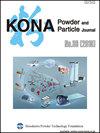剪切细胞装置从准静态到中间状态:理论和表征
IF 3.2
4区 材料科学
Q3 ENGINEERING, CHEMICAL
引用次数: 8
摘要
设计用于加工和制造颗粒产品的新技术需要在广泛的条件下了解颗粒流变学。粉末由于其在应力下重新排列的能力而表现出复杂的行为,因此,颗粒流动通常分为三种流动状态,即由摩擦接触主导的准静态状态,由碰撞和运动应力主导的惯性状态,以及三种应力源对建立应力-应变率关系很重要的中间状态。流动性的特征通常局限于准静态状态下的流动起始,即使在涉及密集流动控制的实际应用中,例如粉末处理、颗粒形成过程或增材制造,过渡到惯性条件非常常见。这项工作提出了一个关键的审查现有的技术,以表征从准静态状态到中间流动的离开。我们修改了剪切单元的应用,并提出了不同的策略来修改具有外部驱动的经典装置,如曝气,以在更高的惯性数下运行。我们特别关注采用充气库埃特流配置的创新设计,强调标准化的复杂性和向通用模型推进的挑战。本文章由计算机程序翻译,如有差异,请以英文原文为准。
From Quasi-static to Intermediate Regimes in Shear Cell Devices: Theory and Characterisation
The design of new technology for processing and manufacturing particulate products requires understanding granular rheology over a broad range of conditions. Powders display a complex behaviour due to their ability to rearrange under stress, and as a result, granular flow is generally classified into three flow regimes, namely a quasi-static regime dominated by frictional contacts, an inertial regime dominated by collisional and kinematic stresses and an intermediate regime where the three sources of stress are important to establish a stress-strain rate relationship. Characterisation of the flowability is generally restricted to the flow initiation in quasi-static regime, even if, transition into inertial conditions is very common in practical applications involving the control of dense flows, such as powder handling, particle formation processes or additive manufacturing. This work presents a critical review of available techniques to characterise the departure from the quasi-static regime into an intermediate flow. We revise the application of shear cells and present different strategies to modify classic devices with external actuation, such as aeration, to operate at higher inertial numbers. We pay particular attention to innovative designs using aerated Couette flow configurations, highlight the complexity in the standardisation and the challenges in advancing towards a universal model.
求助全文
通过发布文献求助,成功后即可免费获取论文全文。
去求助
来源期刊

KONA Powder and Particle Journal
工程技术-材料科学:综合
CiteScore
8.40
自引率
4.90%
发文量
35
审稿时长
>12 weeks
期刊介绍:
KONA publishes papers in the broad field of powder science and technology, ranging from fundamental principles to practical applications. Papers describing technological experience and critical reviews of existing knowledge in special areas are also welcome.
 求助内容:
求助内容: 应助结果提醒方式:
应助结果提醒方式:


